Effects of Climate Change at Treeline: Lessons from Space-for-Time Studies, Manipulative Experiments, and Long-Term Observational Records in the Central Austrian Alps
Abstract
1. Introduction
- The space-for-time approach [15,29,30] uses variations of environmental conditions along altitudinal gradients, where warmer temperatures at lower elevations represent a likely future climate, while lower temperatures at higher elevations represent the present. Such variations in environmental conditions offer a great possibility for comparative research on ecophysiological adaptations to environmental alterations [24,29,31] with minimal confounding biogeographic influence and maximal interpretability [32]. Elevational transects are also considered as powerful tools to investigate climate-driven changes in tree growth [33,34].
- In-situ manipulative warming and rain shelter experiments are common methodologies for assessing the effects of rapid climate change [35]. They can be quite effective in simulating climate warming [36,37,38,39] and top soil drought [40,41] in high elevation forests. Compared to the space-for-time approach, such techniques provide an explicit control in simulating climate warming or artificial soil drought.
- Time series data [35] of tree growth and stable isotopes coupled with time series data of climate may facilitate a mechanistic understanding of climate-related influences on physiological processes, such as leaf gas exchange and stem wood formation, in response to recent climate warming and increasing CO2 concentration [42].
2. The Treeline Environment
3. Tree Growth at Treeline
3.1. Height Growth
3.2. Diameter Growth
| Elevation (m) | Whole Tree NSC Pool (% Dry Weight) | Needle (%) | Branch (%) | Stem (%) | Root (%) |
|---|---|---|---|---|---|
| 2175 | 4.7 ± 1.2 | 61 | 16 | 11 | 12 |
| 2100 | 4.0 ± 0.8 | 51 | 12 | 21 | 16 |
| 1950 | 3.9 | 49 | 7 | 26 | 18 |
| 1750 | 3.8 ± 1.1 | 47 | 7 | 25 | 21 |
4. Water and Carbon Relations within the Treeline Ecotone
4.1. Water Relations
4.2. Carbon Relations
4.3. Long Term Trends in Carbon and Water Relations
5. Treeline Fluctuations
6. Conclusions and Climate Change Perspectives
Author Contributions
Funding
Conflicts of Interest
References
- Däniker, A. Biologische Studien über Baum- und Waldgrenzen, insbesondere über die klimatischen Ursachen und deren Zusammenhänge. Vierteljahresschrift der Naturforschenden Gesellschaft Zürich 1923, 68, 1–102. [Google Scholar]
- Holtmeier, F.-K. Geoökologische Beobachtungen und Studien an der subarktischen und Alpinen Waldgrenze in Vergleichender Sicht; Steiner: Wiesbaden, Germany, 1974. [Google Scholar]
- Holtmeier, F.-K. Mountain Timberlines. Ecology, Patchiness, and Dynamics; Advances in Global Change Research; Kluwer Academic: Dordrecht, The Netherlands; Boston, MA, USA; London, UK, 2009; Volume 36. [Google Scholar]
- Wardle, P. Alpine timberlines. In Arctic and Alpine Environments; Ives, J.D., Barry, R., Eds.; Methuen Publishing: London, UK, 1974; pp. 371–402. [Google Scholar]
- Tranquillini, W. Physiological ecology of the alpine timberline. In Tree Existence at High Altitudes With special Reference to the European Alps; Ecological Studies; Springer: Berlin, Germany, 1979; Volume 31. [Google Scholar]
- Slatyer, R.O.; Noble, I.R. Dynamics of treelines. In Landscape Boundaries: Consequences for Biotic Diversity and Ecological Flows; Ecological Studies; Hansen, A., DiCastri, F., Eds.; Springer: Berlin, Germany; New York, NY, USA, 1992; Volume 92, pp. 346–359. [Google Scholar]
- Wieser, G.; Tausz, M. Trees at Their Upper Limit: Treelife Limitation at the Alpine Timberline; Plant Ecophysiology; Springer: Berlin, Germany, 2007; Volume 5. [Google Scholar]
- Körner, C. Alpine Treelines. Funtional Ecology of the Global High Elevation Tree Limits; Springer: Basel, Switzerland, 2012. [Google Scholar]
- Kullman, L. 20th century climate warming and tree limit rise in the southern Scandes in Sweden. Ambio 2001, 30, 2–80. [Google Scholar] [CrossRef] [PubMed]
- Wieser, G. Lessons from the timberline ecotone in the Central Tyrolean Alps: A review. Plant Ecol. Divers. 2012, 5, 127–139. [Google Scholar] [CrossRef]
- Grace, J.; Berninger, F.; Nagy, L. Impact of climate change on the treeline. Ann. Bot. 2002, 90, 537–544. [Google Scholar] [CrossRef] [PubMed]
- Sveinbjörnsson, B. North American and European treelines: External factors and internal processes controlling position. Ambio 2000, 29, 388–395. [Google Scholar] [CrossRef]
- Körner, C.; Hoch, G. A test of treeline theory on a montane permafrost island. Arct. Antarct. Alpine Res. 2006, 38, 113–119. [Google Scholar] [CrossRef]
- Körner, C.; Paulsen, J. A world-wide study of high altitude treeline temperatures. J. Biogeogr. 2004, 31, 713–732. [Google Scholar] [CrossRef]
- Körner, C. Climatic treelines: Conventions, global patterns, causes. Erdkunde 2007, 61, 316–324. [Google Scholar] [CrossRef]
- Tuhkanen, S. Climatic parameters and indices in plant geography. Acta Phytogenetica Suecica 1980, 67, 1–110. [Google Scholar]
- Ohsawa, M. An interpretation of latitudinal patterns of forest limits in south and East Asian mountains. J. Ecol. 1990, 78, 262–339. [Google Scholar] [CrossRef]
- Wieser, G.; Holtmeier, F.-K.; Smith, W.K.; William, K. Treelines in a changing global environment. In Trees in a Changing Environment; Plant Ecophysiology; Tausz, M., Grulke, N., Eds.; Springer: Dordrecht, The Netherland, 2014; Volume 9, pp. 221–263. [Google Scholar]
- Holtmeier, F.-K. Die Höhengrenze der Gebirgswälder. Arbeiten aus dem Institut für Landschaftsökologie, Band 8; Westfälische Wilhelms-Universität: Münster, Germany, 2000. [Google Scholar]
- Holtmeier, F.K.; Broll, G. Sensitivity and response of northern hemisphere altitudinal and polar treelines to environmental change at landscape and local scales. Glob. Ecol. Biogeogr. 2005, 14, 395–410. [Google Scholar] [CrossRef]
- Holtmeier, F.-K.; Broll, G. Treeline advance—Driving processes and adverse factors. Landsc. Onl. 2007, 1, 1–33. [Google Scholar]
- Walther, G.-R.S.; Pott, R. Climate change and high mountain vegetation shifts. In Mountain Ecosystems. Studies in Treeline Ecology; Broll, G., Keplin, B., Eds.; Springer: Berlin, Germany, 2005; pp. 77–95. [Google Scholar]
- Smith, W.K.; Germino, M.J.; Johnson, D.M.; Reinhardt, K. The altitude of alpine treeline: A bellwether of climate change. Bot. Rev. 2009, 75, 163–190. [Google Scholar] [CrossRef]
- Wieser, G.; Matyssek, R.; Luzian, R.; Zwerger, P.; Pindur, P.; Oberhuber, W.; Gruber, A. Effects of atmospheric and climate change at the timberline of the Central European Alps. Ann. For. Sci. 2009, 66, 402. [Google Scholar] [CrossRef] [PubMed]
- Intergovernmental Panel of Climate Change (IPCC). Climate Change. The Physical Science Basis; Cambridge University Press: Cambridge, UK, 2013. [Google Scholar]
- Böhm, R.; Auer, I.; Brunetti, M.; Maugeri, M.; Nanni, T.; Schöner, W. Regional temperature variability in the European Alps: 1760–1998 from homogenized instrumental time. Int. J. Climatol. 2001, 1801, 1779–1801. [Google Scholar] [CrossRef]
- Beniston, M. Mountain climates and climate change: An overview of processes focusing on the European Alps. Pure Appl. Geophys. 2005, 162, 1587–1606. [Google Scholar] [CrossRef]
- Becker, A.; Körner, C.; Brun, J.-J.; Guisan, A.; Tappeiner, U. Ecological and land use studies along elevational gradients. Mount. Res. Dev. 2007, 27, 58–65. [Google Scholar] [CrossRef]
- Körner, C. Carbon limitation in trees. J. Ecol. 2003, 94, 4–17. [Google Scholar] [CrossRef]
- Blois, J.L.; Williams, J.W.; Fitzpatrick, M.C.; Jackson, S.T.; Ferrier, S. Space cab substitute for time in predicting climate-change effects on biodiversity. Proc. Natl. Acad. Sci. USA 2015, 110, 9374–9379. [Google Scholar] [CrossRef]
- Larcher, W. Ergebnisse des IBP-Projektes “Zwergstrauchheide Patscherkofel". Sitzungsbericht Österreichische Akademie der Wissenschaften, Math. Naturwiss. Kl. I. 1977, 186, 301–371. [Google Scholar]
- Körner, C. The use of altitude in ecological research. Trends Ecol. Evol. 2007, 22, 569–574. [Google Scholar] [CrossRef] [PubMed]
- King, G.; Gugleri, F.; Fonti, P.; Frank, D.C. Tree growth response along an elevational gradient: Climate or genetics? Oecologia 2013, 173, 1587–1600. [Google Scholar] [CrossRef] [PubMed]
- Jochner, M.; Bugmann, H.; Nötzli, M.; Bigler, C. Tree growth response to changing temperatures across space and time: A fine-scale analysis at the treeline in the Swiss Alps. Trees 2018, 32, 645–660. [Google Scholar] [CrossRef]
- Elmendorf, S.C.; Henry, G.H.R.; Hollister, R.D.; Fossa, M.A.; Gould, W.A.; Hermanutz, L.; Hofgraad, A.; Jonsdottri, I.S.; Levesque, E.; et al. Experiment, monitoring, and gradient methods used to infer climate change effects on plant communities yield constant patterns. Proc. Natl. Acad. Sci. USA 2015, 112, 448–452. [Google Scholar] [CrossRef] [PubMed]
- Gruber, A.; Wieser, G.; Oberhuber, W. Opinion paper: Effects of simulated soil temperature on stem diameter increment of Pinus cembra at the alpine timberline: A new approach based on root zone roofing. Eur. J. For. Res. 2010, 129, 141–144. [Google Scholar] [CrossRef]
- Hagedorn, F.; Martin, M.; Rixen, C.; Rusch, S.; Bebi, P.; Zürcher, A.; Siegwolf, R.T.S.; Wipf, S.; Escape, C.; Roy, J. Short-term responses of ecosystem carbon fluxes to experimental soil warming at the Swiss alpine treeline. Biogeochemistry 2010, 97, 7–19. [Google Scholar] [CrossRef]
- Wieser, G.; Grams, T.E.E.; Matyssek, R.; Oberhuber, W.; Gruber, A. Soil warming increased whole-tree water use of Pinus cembra at the treeline in the Central Tyrolean Alps. Tree Physiol. 2015, 35, 279–288. [Google Scholar] [CrossRef]
- Dawes, M.A.; Schleppi, P.; Hättenschwiler, P.; Hagedorn, F. Soil warming opens the nitrogen cycle at the alpine treeline. Global Change Biol. 2017, 23, 421–434. [Google Scholar] [CrossRef]
- Wieser, G.; Oberhuber, W.; Gruber, A.; Oberleitner, F.; Hasibeder, R.; Bahn, M. Artificial top soil drought hardly affects water use of young Picea abies and Larix decidua trees at treeline in the Austrian Alps. Forests 2019. under review. [Google Scholar]
- Bahn, M.; Erb, K.; Harris, E. ClimLUC—Climate Extremes and Land-Use Change: Effects on Ecosystem Processes and Services; Austrian Academy of Sciences Press: Vienna, Austria, 2018. [Google Scholar] [CrossRef]
- Wieser, G.; Oberhuber, W.; Gruber, A.; Leo, M.; Matyssek, R.; Grams, T.E.E. Stable water use efficiency under climate change of three sympatric conifer species at the Alpine treeline. Front. Plant Sci. 2016, 7, 799. [Google Scholar] [CrossRef][Green Version]
- Theurillat, J.P.; Guisan, A. Potential impact of climate change on vegetation in the European Alps: A review. Clim. Change 2001, 50, 77–109. [Google Scholar] [CrossRef]
- Wieser, G. Climate at the alpine timberline. In Trees at Their Upper Limit. Treelife Limitation at the Alpine Timberline; Plant Ecophysiology; Wieser, G., Tausz, M., Eds.; Springer: Berlin, Germany, 2007; Volume 5, pp. 19–36. [Google Scholar]
- Wieser, G.; Oberhuber, W.; Waldboth, B.; Gruber, A.; Matyssek, R.; Siegwolf, R.T.W.; Gramd, T.E.E. Long-term trends in leaf level gas exchange mirror tree-ring derived intrinsic water-use efficiency of Pinus cembra at treeline during the last century. Agric. For. Meteorol. 2018, 248, 251–258. [Google Scholar] [CrossRef]
- HISTALP. Available online: http://www.zamg.ac.at/histalp/inxex.php (accessed on 11 April 2019).
- Gruber, A.; Wieser, G.; Oberhuber, W. Intra-annual dynamics in stem CO2 efflux in relation to cambial activity and xylem development in Pinus cembra. Tree Physiol. 2009, 29, 641–649. [Google Scholar] [CrossRef] [PubMed]
- Wieser, G.; Oberhuber, W.; Walder, L.; Spieler, D.; Gruber, A. Photosynthetic temperature adaptation of Pinus cembra within the timberline ecotone of the Central Austrian Alps. Ann. For. Sci. 2010, 67, 201. [Google Scholar] [CrossRef] [PubMed]
- Aulitzky, H. Die Bodentemperaturverhältnisse in der Kampfzone oberhalb der Waldgrenze und im subalpinen Zirben-Lärchenwald. Mitteilungen der Forstlichen Bundesversuchsanstalt Mariabrunn 1961, 59, 153–208. [Google Scholar]
- Oberhuber, W. Limited by growth processes. In Trees at Their Upper Limit. Tree Life Limitation at the Alpine Timberline; Plant Ecophysiology; Wieser, G., Tausz, M., Eds.; Springer: Berlin, Germany, 2007; Volume 5, pp. 131–143. [Google Scholar]
- Aulitzky, H. Über die Windverhältnisse einer zentralalpinen Hangstation in der subalpinen Stufe. Mitteilungen der Forstlichen Bundesversuchsanstalt Mariabrunn 1961, 59, 209–230. [Google Scholar]
- Aulitzky, H. Grundlagen und Anwendungen des vorläufigen Wind-Schnee-Ökogramms. Mitteilungen der Forstlichen Bundesversuchsanstalt Mariabrunn 1963, 60, 763–834. [Google Scholar]
- Kronfuss, H. Schneelage und Ausaperung an der Waldgrenze. Mitteilungen der Forstlichen Bundesversuchsanstalt Wien 1967, 75, 207–241. [Google Scholar]
- Kronfuss, H. Räumliche Korrelation zwischen der Windstärke in Bodennähe und der Schneedeckenandauer. Centralblatt für das Gesamte Forstwesen 1970, 87, 99–116. [Google Scholar]
- Kronfuss, H.; Stern, R. Strahlung und Vegetation; Angewandte Pflanzensoziologie; Publishet Forstliche Bundesversuchsanstalt: Wien, Austria, 1978; Volume 24. [Google Scholar]
- Larcher, W. Winter stress in high mountains. In Establishment and Tending of Subalpine Forest: Research and Management; Turner, H., Tranquillini, W., Eds.; Berichte Eidgenössische Anstalt für das forstliche Versuchswesen Birmensdorf: Zürich, Switzerland, 1985; Volume 270, pp. 11–19. [Google Scholar]
- Loris, K. Dickenwachstum von Zirbe, Fichte und Lärche an der alpinen Waldgrenze/Patscherkofel. Ergebnisse der Dendrometermessungen 1976/79. Mitteilungen der Forstlichen Bundesversuchsanstalt Wien 1981, 142, 417–441. [Google Scholar]
- Kronfuss, H. Der Einfluß der Lufttemperatur auf das Höhenwachstum der Zirbe. Centralblatt für das Gesamte Forstwesen 1994, 111, 165–181. [Google Scholar]
- Kanninen, M. Shoot elongation in Scots Pine: Diurnal variations and response to temperature. J. Exp. Bot. 1985, 36, 1760–1770. [Google Scholar] [CrossRef]
- Häsler, R.; Streule, A.; Turner, H. Shoot and root growth of young Larix decidua in contrasting microenvironments neat the alpine timberline. Phyton 1999, 39, 47–52. [Google Scholar]
- Tranquillini, W.; Unterholzner, R. Das Wachstum zweijähriger Lärchen einheitlicher Herkunft in verschiedenen Höhenlagen. Centralblatt für das Gesamte Forstwesen 1968, 85, 43–59. [Google Scholar]
- Havranek, W.M. Gas exchange and dry matter allocation in larch at the alpine timberline on Mount Patscherkofel. In Establishment and Tending of Subalpine Forest: Research and Management; Turner, H., Tranquillini, W., Eds.; Berichte Eidgenössische Anstalt für das forstliche Versuchswesen Birmensdorf: Zürich, Switzerland, 1985; Volume 270, pp. 135–142. [Google Scholar]
- Sveinbjörnsson, B.; Nordell, O.; Kauhanen, H. Nutrient relations of mountain birch growth at and below the elevational tree-line in Swedish Lapland. Funct. Ecol. 1992, 6, 213–220. [Google Scholar] [CrossRef]
- LeBauer, D.S.; Treseder, K.K. Nitrogen limitation of net primary productivity in terrestrial ecosystems is globally distributed. Ecology 2008, 89, 371–379. [Google Scholar] [CrossRef]
- Nadelhoffer, J.K.; Giblin, A.E.; Shaver, G.R.; Laiúndre, J.A. Effects of temperature and substrate quality on element mineralization in six Arctic soils. Ecology 1991, 72, 242–253. [Google Scholar] [CrossRef]
- Rustad, L.E.; Campbell, J.L.; Marion, G.M.; Norby, R.J.; Mitchell, M.J.; Hartley, A.E.; Cornelissen, J.H.C.; Gurevitch, J. GCTE-NEWS. A meta analysis of the response of soil respiration, net nitrogen mineralization, and aboveground plant growth to experimental ecosystem warming. Oecologia 2001, 126, 543–562. [Google Scholar] [CrossRef]
- Melillo, J.M.; Steudler, P.A.; Aber, J.D.; Newkirk, K.; Lux, H.; Bowles, F.P.; Catricala, C.; Magill, A.; Ahrens, T.; Morrisseau, S. Soil warming and carbon-cycle feedback to the climate system. Science 2002, 298, 2173–2176. [Google Scholar] [CrossRef]
- Platt, K.H.; Allen, R.B.; Coomes, D.A.; Wiseer, S.K. Mountain beech seedling responses to removal of below-ground competition and fertiliser addition. N. Z. J. Ecol. 2004, 28, 289–293. [Google Scholar]
- Song, H.; Cheng, S.; Zhang, Y. The growth of two species of subalpine conifer sapliplings in response to soil warming and inter-competition in Mt. Gongga on the south-eastern fringe of the Qinghai-Tibetan plateau, China. World J. Eng. Technol. 2016, 4, 398–412. [Google Scholar] [CrossRef]
- Paulsen, J.; Weber, U.M.; Körner, C. Tree growth near treeline: Abrupt or gradual reduction with altitude? Arct. Antarct. Alpine Res. 2000, 32, 14–20. [Google Scholar] [CrossRef]
- Oswald, H. Verteilung und Zuwachs der Zirbe (Pinus cembra) de subalpinen Stufe an einem zentralalpinen Standort. Mitteilungen der Forstlichen Bundesversuchsanstalt Mariabrunn 1963, 60, 437–499. [Google Scholar]
- Kronfuss, H.; Havranek, W.M. Effects of elevation and wind on the growth of Pinus cembra L. in a subalpine afforestation. Phyton 1999, 39, 99–106. [Google Scholar]
- Li, M.H.; Yang, J. Effects of microsite on growth of Pinus cembra in the subalpine zone of the Austrian Alps. Ann. For. Sci. 2004, 61, 319–325. [Google Scholar] [CrossRef]
- Li, M.H.; Yang, J.; Kräuchi, N. Growth response of Picea abies and Larix decidua to elevation in subalpine areas of Tyrol, Austria. Can. J. For. Res. 2003, 33, 653–662. [Google Scholar] [CrossRef]
- Holtmeier, F.-K.; Broll, G. Altitudinal and polar treelines in the northern hemisphere - causes and response to climate change. Polarforschung 2010, 79, 139–153. [Google Scholar]
- Vaganov, E.A.; Hughes, M.K.; Kirdyanov, A.V.; Schweingruber, F.H.; Silkin, P.P. Influence of snowfall and melting time on tree growth in subarctic Eurasia. Nature 1999, 400, 149–151. [Google Scholar] [CrossRef]
- Lupi, C.; Morin, H.; Deslauries, A.; Rossi, S. Xylogenesis in black spruce: Does soil temperature matter? Tree Physiol. 2012, 32, 74–82. [Google Scholar] [CrossRef]
- Rossi, S.; Deslauries, A.; Anfodillo, T.; Morin, H.; Saracino, A.; Motta, R.; Borghetti, M. Conifers in cold environments synchronyze maximum growth rate of tree-ring formation with day length. New Phytol. 2006, 170, 301–310. [Google Scholar] [CrossRef]
- Gruber, A.; Zimmenmann, J.; Wieser, G.; Oberhuber, W. 2. Effects of climate variables on intra-annual stem radial increment in Pinus cembra (L.) along the timberline ecotone. Ann. For. Sci. 2009, 66, 503. [Google Scholar] [CrossRef] [PubMed]
- Strömgren, M.; Linder, S. Effects of nutrition and soil warming on stemwood production in a boreal Norway spruce stadns. Glob. Ghange Biol. 2002, 8, 1194–1204. [Google Scholar]
- Dao, M.C.E.; Rossi, R.; Walsh, D.; Morin, H.; Houle, D. A 6-yer-long manipulation with soil warming and canopy nitrogen additions does not affect xylem phenology and cell production of mature black spruce. Front. Plant Sci. 2015, 6, 877. [Google Scholar] [CrossRef] [PubMed]
- Dawes, M.A.; Philipson, C.D.; Fonti, P.; Bebi, P.; Hättenschwiler, S.; Hagedorn, F.; Rixen, C. Soil warming and CO2 enrichment induce biomass shifts in alpüine treeline vegetation. Glob. Change Biol. 2015, 21, 2005–2021. [Google Scholar] [CrossRef]
- Loranger, H.; Zotz, G.; Bader, M.Y. Early establishment of trees at the alpine treeline: Idiosyncratic species responses to temperature-moisture interactions. AOB Plants 2016, 8, plw053. [Google Scholar] [CrossRef] [PubMed]
- Gruber, A.; Oberhuber, W.; Wieser, G. Nitrogen addition and understory removal but not soil warming increases radial growth of Pinus cembra at treeline in the Central Austrian Alps. Front. Plant Sci. 2018, 9, 711. [Google Scholar] [CrossRef] [PubMed]
- Anschlag, K.; Broll, G.; Holtmeier, F.-K. Mountain birchseedlings in the treeline ecotone, subarctic Finland: Variationin above-and below grond growth depending onmicrotopography. Arct. Antarct. Alpine Res. 2008, 40, 609–616. [Google Scholar] [CrossRef]
- Brodersen, C.R.; Germino, M.J.; Johnson, D.M.; Reinhardt, K.; Smith, W.K.; Resler, L.M.; Bader, M.Y.; Sala, A.; Kueppers, L.M.; Broll, G. Seedling survival at timberline is critical to conifer mountain forest elevation and extent. Front. For. Global Change 2019, 2, 9. [Google Scholar] [CrossRef]
- Batllori, E.; Camarero, J.J.; Gutierrez, E. Current regeneration patterns at the treeline in the Pyrenees indicate similar recruitment processes irrespective to the past disturbance regime. J. Biogeogr. 2010, 37, 1938–1950. [Google Scholar]
- Elliott, G.P. Influences of 20th century warming at the upper treeline contingent on local-scale interactions: Evidence from a latitudinal gradient in the Rocky Mountains, USA. Glob. Ecol. Biogeogr. 2011, 20, 46–57. [Google Scholar] [CrossRef]
- Grau, O.; Ninot, J.M.; Blanco-Moreno, J.M.; van Logtestijn, R.S.P.; Cornelissen, J.H.C.; Callaghan, T.V. Shrub-tree interactions and environmental changes drive treeline dynamics in the Subarctic. Oikos 2012, 121, 1680–1690. [Google Scholar] [CrossRef]
- Liang, E.; Wang, Y.; Pizo, S.; Lu, X.; Camarero, J.J.; Zhu, H.; Zhu, L.; Ellison, A.M.; Ciaias, P.; Penuelas, J. Species interactions slow warming-induced upward shifts of treelines on the Tibetan Plateau. Proc. Natl. Acad. Sci. USA 2016, 113, 4380–4385. [Google Scholar] [CrossRef] [PubMed]
- Camarero, J.J.; Linares, J.C.; Garcia-Cervigon, A.L.; Batllori, E.; Martinez, I.; Gutierrez, E. Back to the future: The responses of alpine treelines to climate warming are constrained by the current ecotone structures. Ecosystems 2017, 20, 683–700. [Google Scholar] [CrossRef]
- Gruber, A.; Pirkebner, D.; Oberhuber, W.; Wieser, G. Spatial and seasonal variations in mobile carbohydrates i Pinus cembre in the treeline ecotone of the Central Austrian Alps. Eur. J. For. Res. 2011, 130, 173–179. [Google Scholar] [CrossRef]
- Oberhuber, W. Influence of climate on radial growth of Pinus cembra within the alpine timberline ecotone. Tree Physiol. 2004, 24, 219–301. [Google Scholar] [CrossRef] [PubMed]
- Bernoulli, M.; Körner, C. Dry matter allocation in treeline trees. Phyton 1999, 39, 7–12. [Google Scholar]
- Mayr, S. Limits in water relations. In Trees at Their Upper Limit. Treelife Limitation at the Alpine Timberline; Wieser, G., Tausz, M., Eds.; Springer: Dordrecht, The Netherlands, 2007; pp. 145–162. [Google Scholar]
- Anfodillo, T.; Rento, S.; Carraro, V.; Furlanetto, L.; Urbinati, C.; Carrer, M. Tree water relations and climatic variations at the alpine timberline: Seasonal changes of sap flux and xylem water potential in Larix decidua Miller, Picea abies (L.) Karst. and Pinus cembra L. Ann. For. Sci. 1998, 55, 159–172. [Google Scholar] [CrossRef]
- Wieser, G.; Gruber, A.; Oberhuber, W. Sap flow characteristics and whole-tree water use of Pinus cembra across the treeline ecotone of the central Tyrolean Alps. Eur. J. For. Res. 2014, 133, 287–295. [Google Scholar] [CrossRef]
- Aulitzky, H. The microclimatic conditions in a subalpine forest as basis for the management. Geo J. 1984, 8, 277–281. [Google Scholar] [CrossRef]
- Caldwell, M. The effect of wind on stomatal aperture, photoynthesis, and transpiration of Rhododendron ferrugineum L. and Pinus cembra L. Centralblatt für das gesamte Fortswesen 1970, 87, 193–201. [Google Scholar]
- Caldwell, M. Pant gas exchange at high wind speeds. Plant Physiol. 1970, 46, 535–537. [Google Scholar] [CrossRef] [PubMed]
- Goldstein, G.H.; Brubaker, L.B.; Hinckley, T.M. Water relations of white spruce (Picea glauca (Moench(Voss)) at tree line in north central Alaska. Can. J. For. Res. 1985, 15, 1080–1087. [Google Scholar] [CrossRef]
- Wan, X.; Zwiazek, J.J. Mercuric chloride effects on root water transport in aspen seedlings. Plant Physiol. 1999, 121, 939–946. [Google Scholar] [CrossRef] [PubMed]
- Wan, X.; Zwiazek, J.J.; Lieffers, V.J.; Landhäusser, S.M. Hydraulic conductance in aspen (Populus tremuloides) seedlings exposed to low root temperatures. Tree Physiol. 2001, 21, 691–696. [Google Scholar] [CrossRef] [PubMed]
- McElrone, A.J.; Bichler, J.; Pockman, W.T.; Addington, R.N.; Linder, C.R.; Jackson, R.B. Aquaporin-mediated changes in hydraulic conductivity of deep tree roots accessed via caves. Plant Cell Environ. 2007, 30, 1411–1421. [Google Scholar] [CrossRef] [PubMed]
- Ruggiero, C.; Angelino, G.; Maggio, A. Developmental regulation of water uptake in wheat. J. Plant Physiol. 2007, 164, 1170–1178. [Google Scholar] [CrossRef] [PubMed]
- Rainer, G.; Kuhnert, R.; Unterholzer, M.; Dresch, P.; Gruber, A.; Peintner, U. Host-specialist dominated ectomycorrhizal communities of Pinus cembra are not affected by temperature manipulation. J. Fungi 2015, 1, 55–75. [Google Scholar] [CrossRef] [PubMed]
- Valentini, R.; Anfodillo, T.; Ehlringer, J. Water sources utilization and carbon isotope composition (δ13C) of co-occurring species along an altitudinal gradient in the Italian Alps. Can. J. For. Res. 1994, 24, 1575–1578. [Google Scholar] [CrossRef]
- Walder, L.M. Der Gaswechsel der Zirbe (Pinus cembra L.) im Waldgrenzökoton am Patschertkofel. Diploma Thesis, Botany, University Innsbruck, Tyrol, Austria, June 2007. [Google Scholar]
- Birmann, K.; Körner, C. Nitrogen status of conifer needles at the alpine treeline. Plant Ecol. Divers. 2009, 2, 233–241. [Google Scholar] [CrossRef]
- Pisek, A.; Winkler, E. Assimilationsvermögen und Respiration der Fichte (Picea excelsa LINK) in verschiedenen Höhenlagen und der Zirbe (Pinus cembra L.) an der Waldgrenze. Planta 1958, 51, 518–543. [Google Scholar] [CrossRef]
- Pisek, A.; Larcher, W.; Moser, W.; Pack, I. Kardinale Temperaturbereiche der Photosynthese und Grenztemperaturen des Lebens der Blätter verschiedener Spermatophyten. III. Temperaturabhängigkeit und optimaler Temperaturbereich der Nettophotosynthese. Flora 1969, Ab. B 158, 608–630. [Google Scholar]
- Wieser, G. Carbon dioxide gas exchange of cembran pine (Pinus cembra) at the alpine timberline during winter. Tree Physiol. 1997, 17, 473–477. [Google Scholar] [CrossRef] [PubMed]
- Havranek, W.M.; Tranquillini, W. Physiological processes during winter dormancy and their ecological significace. In Ecophysilogy of Coniferous Forest; Smith, W.K., Hinckley, T.M., Eds.; Academic Press: San Diego, CA, USA, 1995; pp. 95–124. [Google Scholar]
- Larcher, W. Ökophysiologie der Pflanzen: Leben, Leistung und Stressbewältigung der Pflanzen in ihrer Umwelt; UTB für Wissenschaft: Ulmer Stuttgart, Germany, 2001. [Google Scholar]
- Cartellieri, E. Jahresgang von osmotischem Wert, Transpiration und Assimilation einiger Ericaceen der alpinen Zwergstrauchheide und von Pinus cembra. Jahrbuch für Wissenschaftliche Botanik 1935, 82, 460–506. [Google Scholar]
- Marchin, R.E.; Broadhead, A.A.; Bostic, L.E.; Dunn, R.R.; Hoffmann, W.A. Stomatal acclimation to vapor pressure deficit doubles transpiration of small tree seedlings with warming. Plant Cell Environ. 2016, 39, 2221–2234. [Google Scholar] [CrossRef] [PubMed]
- Saurer, M.; Spahni, R.; Frank, D.C.; Joos, F.; Leuenberger, M.; Loader, N.J.; Mc Carrol, D.; Gagen, M.; Poulter, B.; Sierwolf, R.T.S.; et al. Spatial variability and temporal trends in water-use efficiency of European forest. Global Change Biol. 2014, 20, 332–336. [Google Scholar] [CrossRef] [PubMed]
- Koch, W.; Klein, W.; Walz, H. Neuartige Gaswechsel-Messanlage für Pflanzen in Laboratorium und Freiland. Siemens Zeitschrift 1968, 42, 392–404. [Google Scholar]
- Havranek, W.M. Stammatmung, Dickenwachstum und Photosynthese einer Zirbe (Pinus cembra) an der Waldgrenze. Mitteilungen der Forstlichen Bundesversuchsanstalt Wien 1981, 142, 443–467. [Google Scholar]
- Wieser, G.; Häsler, R.; Götz, B.; Koch, W.; Havranek, W.M. Role of climate, crown position, tree age and altitude in calculated ozone flux into needles of Picea abies and Pinus cembra: A synthesis. Environ. Pollut. 2000, 110, 415–422. [Google Scholar] [CrossRef]
- Wieser, G. Environmental control of carbon dioxide gas exchange in needles of a mature Pinus cembra tree at the alpine timberline during the growing season. Phyton 2004, 44, 145–153. [Google Scholar]
- Havranek, W.M.; Wieser, G.; Bodner, M. Ozone fumigation of Norway spruce at timberline. Ann. Sci. For. 1989, 46s, 581–585. [Google Scholar] [CrossRef]
- Benecke, U.; Schulze, E.-D.; Matyssek, R.; Havranek, W.M. Environmental control of CO2-assimilation and leaf conductance in Larix decidua Mill. I. a comparison of contrasting natural environments. Oecologia 1981, 50, 54–61. [Google Scholar] [CrossRef] [PubMed]
- Volgger, E. Zur Ozonempfindlichkeit der europäischen Lärche (Larix decidua Mill.) an der Waldgrenze. Diploma Thesis, Botany, University of Innsbruck, Innsbruck, Austria, 1995. [Google Scholar]
- Stöhr, D. Soils - heterogeneous at a microscale. In Trees at Their Upper Limit. Tree Life Limitation at the Alpine Timberline; Plant Ecophysiology; Wieser, G., Tausz, M., Eds.; Springer: Berlin, Germany, 2007; Volume 5, pp. m37–m56. [Google Scholar]
- Carcaillet, C. Changes in landscape structure in the northwestern Alps over the last 7000 years: Lessons from soil charcoal. J. Veg. Sci. 2000, 11, 705–714. [Google Scholar] [CrossRef]
- Tinner, W.; Theurillat, J.P. Uppermost limit, extent, and fluctuations of the timberline and treeline ecocline in the Swiss Central Alps during the past 11500 yr. Arct. Antarct. Alpine Res. 2003, 35, 158–169. [Google Scholar] [CrossRef]
- Bortenschlager, S. Beiträge zur Vegetationsgeschichte Tirols. I. Inneres Ötztal und unteres Inntal. Berichte des Natrurwissenschaftlich-MedizinischenVereins in Innsbruck 1984, 71, 19–56. [Google Scholar]
- Patzelt, G. Modellstudie Ötztal—Landschaftsgeschichte in Hochgebirgsraum. Mitteilungen der Österreichischen Geographischen Gesellschaft 1996, 138, 53–70. [Google Scholar]
- Sturmböck, M. Die spät- und Postglaziale Vegetationsgeschichte des Nordwestlichen Südtirols. Dissertationes Botanicae; Cramer: Berlin, Germany, 1999; Volume 299. [Google Scholar]
- Leidlmair, A. Landeskunde Österreich. Landesnatur, Kulturlandschaft, Bevölkerung, Wirtschaft, Die Bundesländer; Paul List (Verlag): München, Germany, 1983. [Google Scholar]
- Luzian, R.; Pindur, P. Prähistorische Lawinen. Nachweis und Analyse holozäner Lawinenereignisse in den Zillertaler Alpen, Österreich; Mitteilungen der Kommission für Quartärforschung der Österreichische Akademie der Wissenschaft: Wien, Austria, 2007; Volume 16. [Google Scholar]
- Zwerger, P.; Pindur, P. Waldverbreitung und Waldentwicklung im Oberen Zemmgrund. In Prähistorische Lawinen. Nachweis und Analyse holozäner Lawinenereignisse in den Zillertaler Alpen; Luzian, R., Pindur, P., Eds.; BFW Berichte: Wien, Austria, 2007; Volume 141, pp. 69–97. [Google Scholar]
- Neuwinger-Raschendorfer, I. Bodenfeuchtemessungen. Mitteilungen der Forstlichen Bundesversuchsanstalt Mariabrunn 1963, 59, 257–264. [Google Scholar]
- Cernusca, A. Aims and tasks of ECOMONT. In Land-Use Changes in European Mountain Ecosystems. ECOMONT—Concepts and Results; Cernusca, A., Tappeiner, U., Bayfield, N., Eds.; Blackwell: Berlin, Germany, 1999; pp. 13–35. [Google Scholar]
- Smith, W.K.; Germino, M.J.; Hanckock, T.E.; Johnson, D.M. Another perspective on altitudinal limits of alpine timberlines. Tree Physiol. 2003, 23, 1101–1112. [Google Scholar] [CrossRef]
- Gehring-Fasel, J.; Gusian, A.; Zimmermann, N.E. Tree line shifts in the Swiss Alps: Climate change or land abandonment. J. Veg. Sci. 2007, 18, 571–582. [Google Scholar] [CrossRef]
- Hättenschwiler, S.; Körner, C. Responses to recent climate warming of Pinus sylvestris and Pinus cembra within their montane transition zone in the Swiss Alps. J. Veg. Sci. 1995, 6, 357–368. [Google Scholar] [CrossRef]
- Mooney, H.A.; Winner, W.E. Partitioning response of plants to stress. In Response of Plants to Multiple Stresses; Mooney, H.A., Winner, W.E., Pell, E.J., Eds.; Academic Press: San Diego, CA, USA, 1991; pp. 129–141. [Google Scholar]
- Callaway, R.M. Competition and facilitation on elevation gradients in subalpine forests in the northern Rock Mountains, USA. Oikos 1998, 82, 561–573. [Google Scholar] [CrossRef]
- Seidl, R.; Thom, D.; Kautz, M.; Martin-Benito, D.; Peltoniemi, M.; Vacchiano, G.; Wild, J.; Ascoli, D.; Petr, M.; Honkaniemi, J.; et al. Forest disturbances under climate change. Nat. Clim. Change 2017, 7, 395–2017. [Google Scholar] [CrossRef] [PubMed]
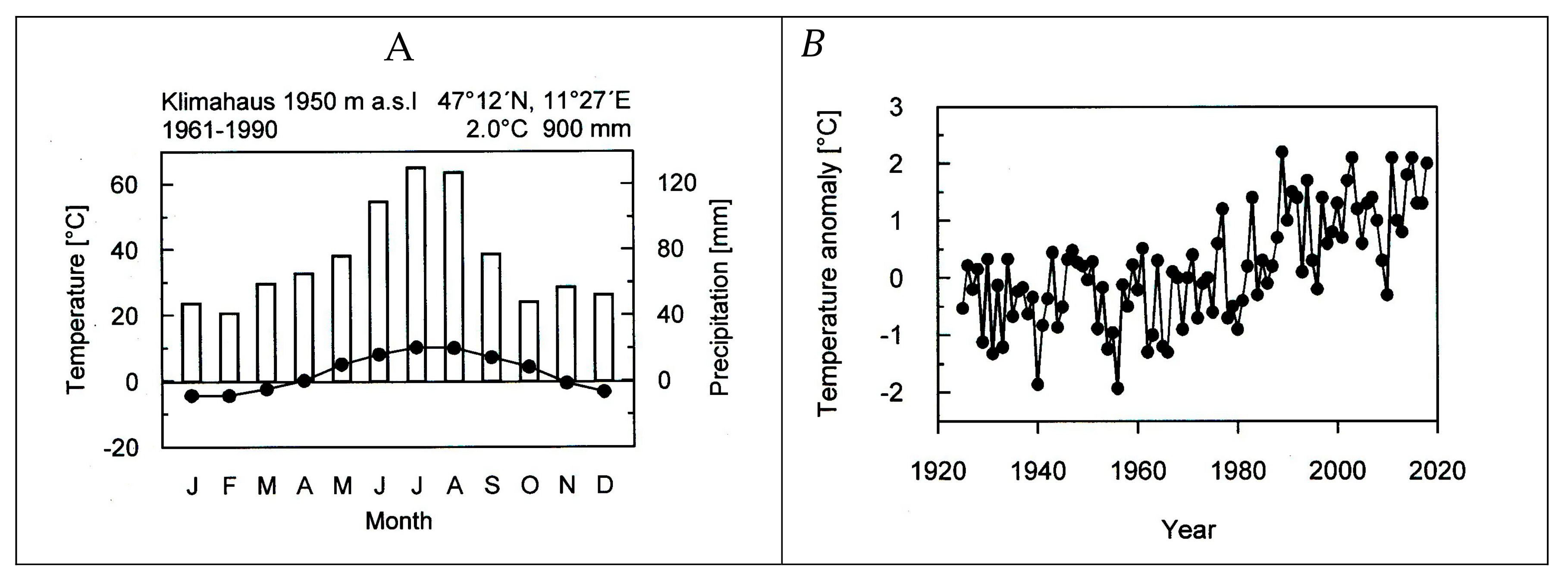
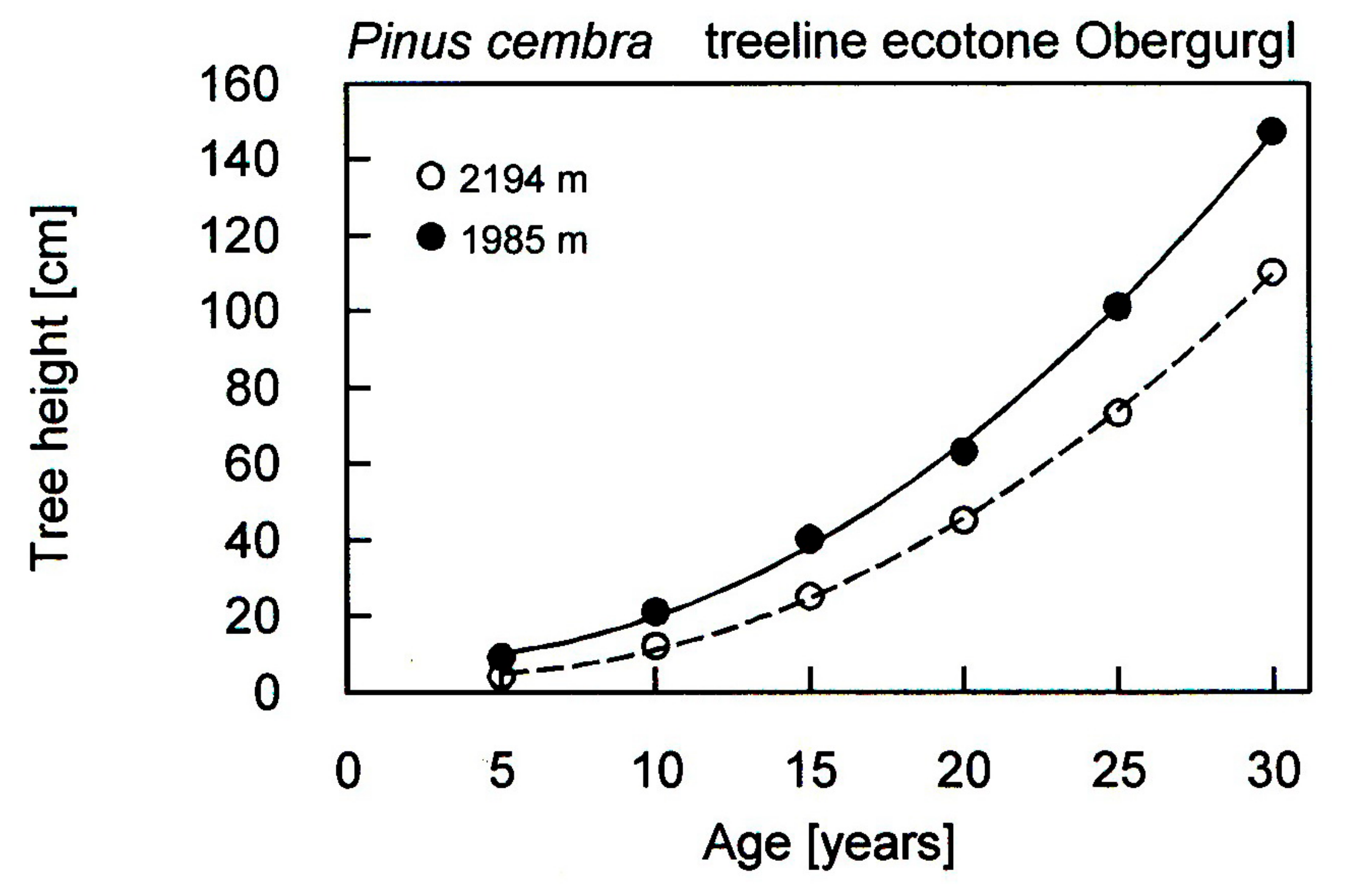
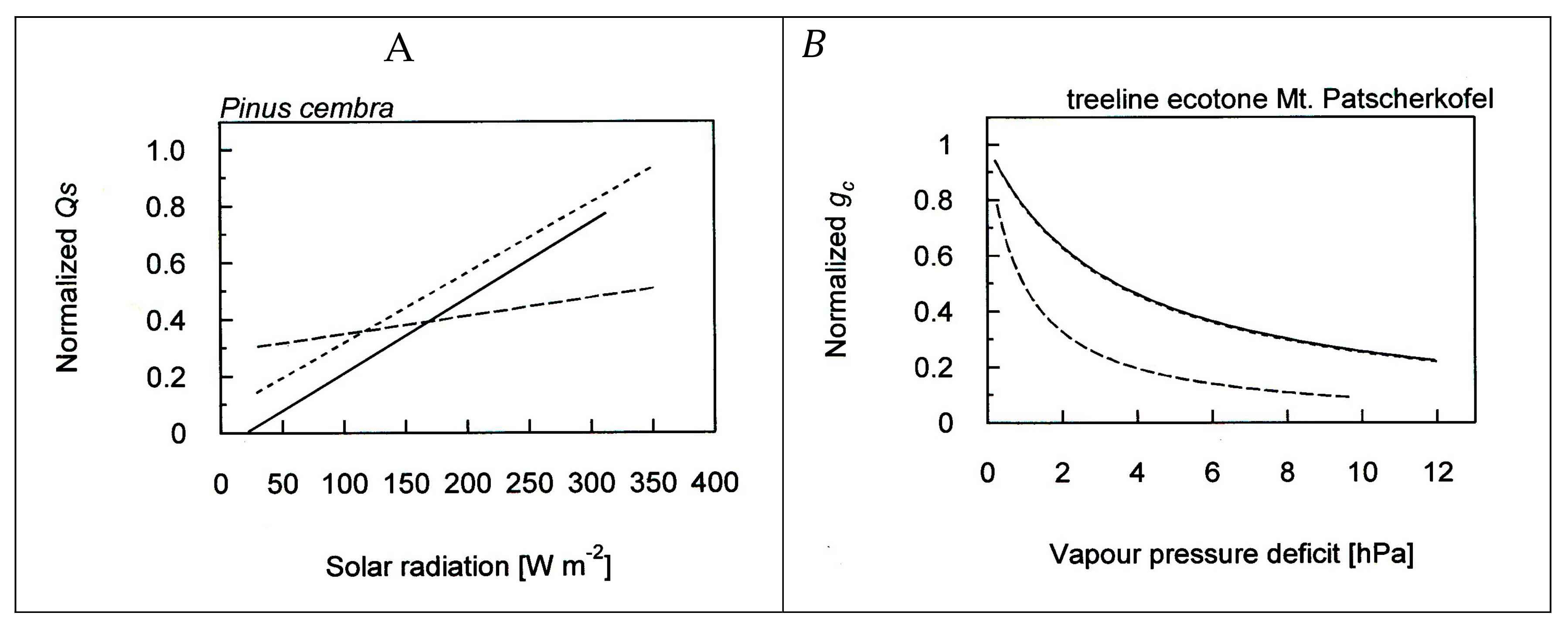
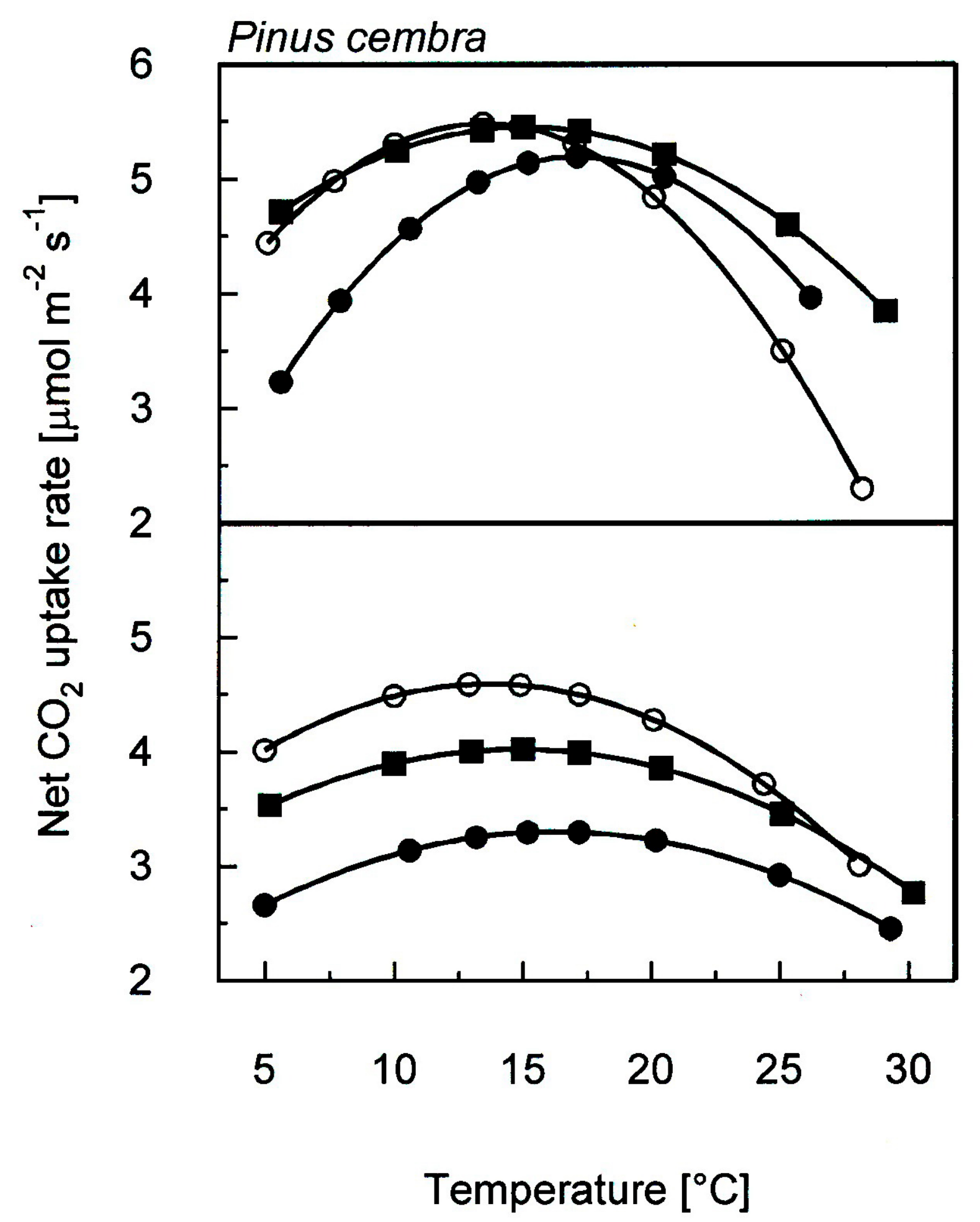
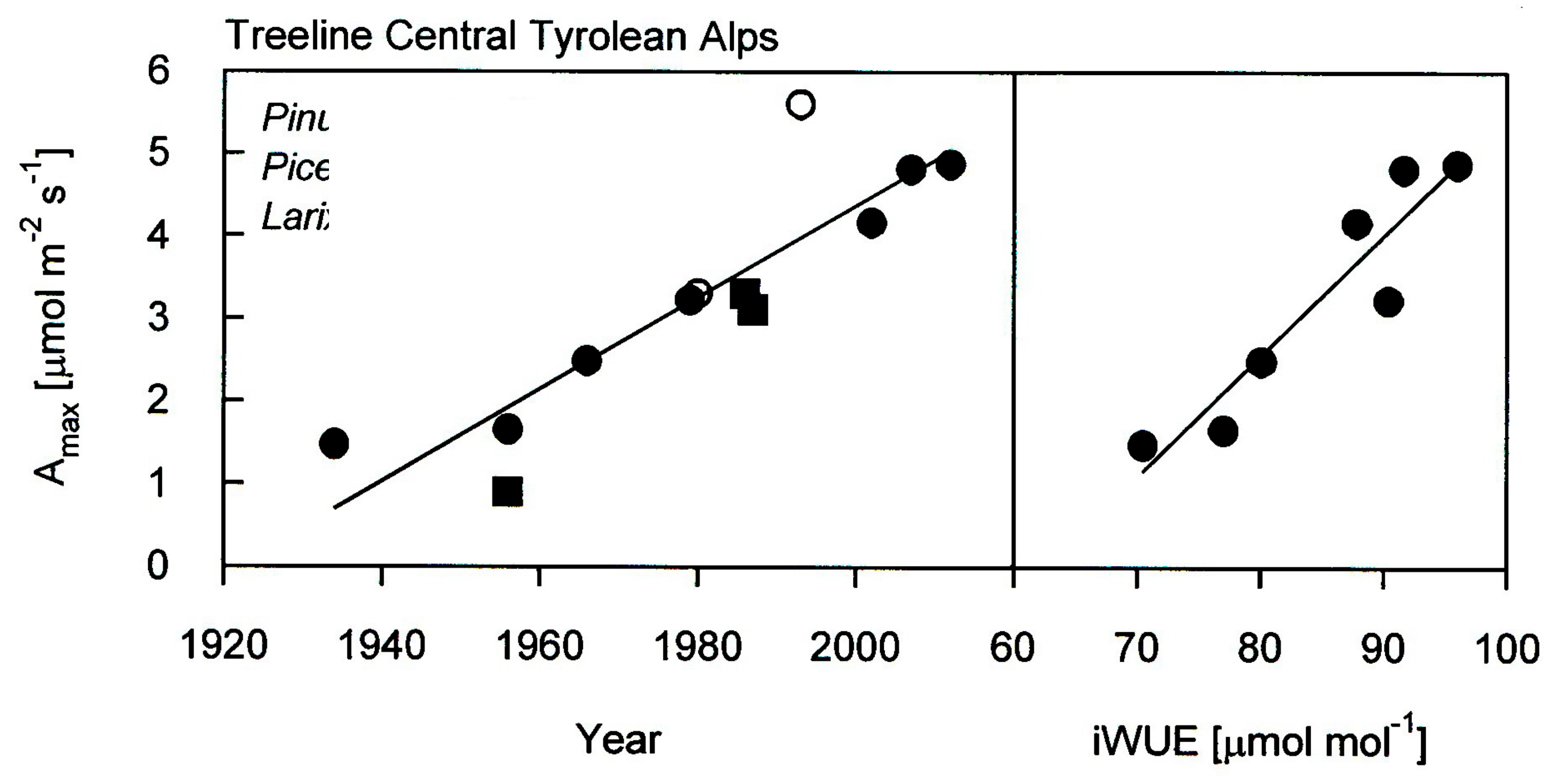
| Absolute Values | Relative Values (%) | |||||
|---|---|---|---|---|---|---|
| 1730 m | 1800 m | 1900 m | 1730 m | 1800 m | 1900 m | |
| Annual height increment (cm) | 24.1 | 21.8 | 11.8 | 100 | 90 | 49 |
| Growing season (days) | 112 | 107 | 99 | 100 | 96 | 88 |
| Wind velocity (m s−1) | 1.2 | 1.3 | 3.1 | 100 | 108 | 258 |
| Elevation (m) | 100-Needle Dry Weight (g) | SLA (cm2 g−1) |
|---|---|---|
| 2180 | 1.04 ± 0.97 | 36.5 ± 1.0 |
| 2100 | 1.31 ± 0.72 | 35.4 ± 0.8 |
| 1950 | 1.29 ± 0.67 | 43.8 ± 0.7 |
| Elevation (m) | Tair (°C) | Rd (µmol m−2 s−1) | Q10 |
|---|---|---|---|
| 2175 | 9.1 | 0.27 | 2.5 |
| 2100 | 10.0 | 0.28 | 2.3 |
| 1950 | 11.1 | 0.31 | 2.0 |
© 2019 by the authors. Licensee MDPI, Basel, Switzerland. This article is an open access article distributed under the terms and conditions of the Creative Commons Attribution (CC BY) license (http://creativecommons.org/licenses/by/4.0/).
Share and Cite
Wieser, G.; Oberhuber, W.; Gruber, A. Effects of Climate Change at Treeline: Lessons from Space-for-Time Studies, Manipulative Experiments, and Long-Term Observational Records in the Central Austrian Alps. Forests 2019, 10, 508. https://doi.org/10.3390/f10060508
Wieser G, Oberhuber W, Gruber A. Effects of Climate Change at Treeline: Lessons from Space-for-Time Studies, Manipulative Experiments, and Long-Term Observational Records in the Central Austrian Alps. Forests. 2019; 10(6):508. https://doi.org/10.3390/f10060508
Chicago/Turabian StyleWieser, Gerhard, Walter Oberhuber, and Andreas Gruber. 2019. "Effects of Climate Change at Treeline: Lessons from Space-for-Time Studies, Manipulative Experiments, and Long-Term Observational Records in the Central Austrian Alps" Forests 10, no. 6: 508. https://doi.org/10.3390/f10060508
APA StyleWieser, G., Oberhuber, W., & Gruber, A. (2019). Effects of Climate Change at Treeline: Lessons from Space-for-Time Studies, Manipulative Experiments, and Long-Term Observational Records in the Central Austrian Alps. Forests, 10(6), 508. https://doi.org/10.3390/f10060508





